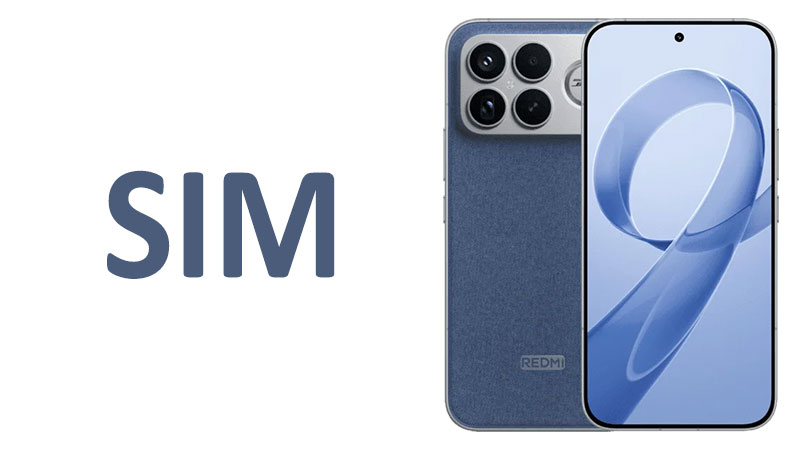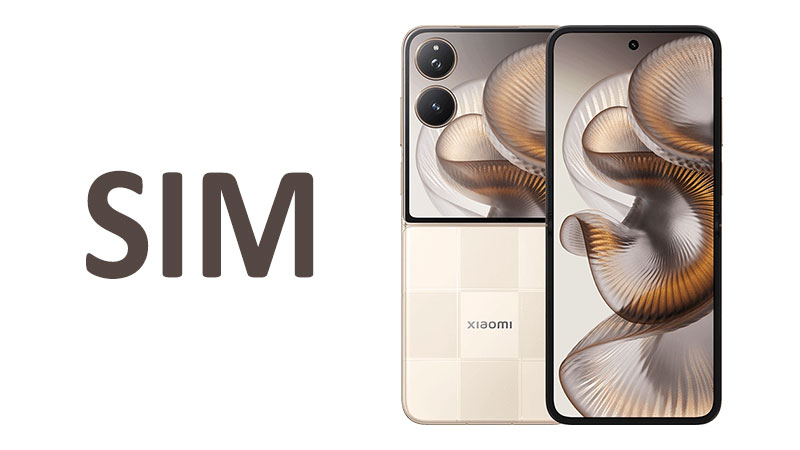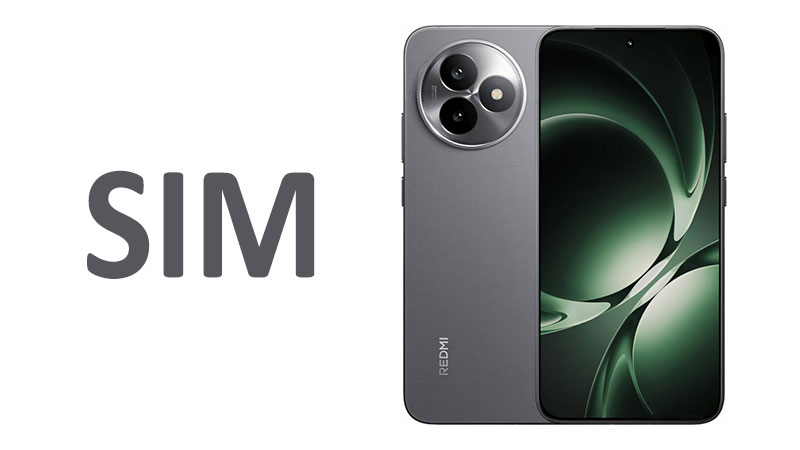The Xiaomi Redmi K90 Pro Max SIM capabilities define its standing as a true connectivity powerhouse. Understanding its dual-SIM configuration is vital for global travelers and multitasking users. The phone supports an impressive array of advanced wireless technologies. These features include 5G, Wi-Fi 7, and the latest Bluetooth standards. This article offers a comprehensive review of the Xiaomi Redmi K90 Pro Max connectivity suite. We will analyze the Dual-SIM setup. We will also examine how its high-speed ports and global navigation systems perform. This detailed review guides prospective buyers through every essential connectivity feature.
Dual-SIM Capability: Nano-SIM x 2
The Xiaomi Redmi K90 Pro Max supports a physical dual-SIM configuration. It exclusively uses two Nano-SIM cards. This setup offers tremendous flexibility for the user. You can manage two separate phone numbers simultaneously. This is highly beneficial for both personal and professional use. Users can keep their business and private contacts segregated. They can also take advantage of different carrier plans.
SIM Tray Configuration
The phone features a tray designed to house two physical Nano-SIM cards. This tray occupies a dedicated slot on the phone’s frame. Both SIM slots are capable of supporting 5G network connectivity. This allows for dual 5G standby. The user can assign one SIM for data and the other for calls. Alternatively, they can use both for seamless coverage switching. This configuration ensures consistent, high-speed connection availability.
Specialized Comparison: Dual-SIM vs. eSIM
The K90 Pro Max employs a traditional Nano-SIM + Nano-SIM setup. This contrasts with the growing trend of eSIM integration found in some competitors. Traditional SIMs offer easier swapping between phones. They also provide simple access for temporary local travel SIMs. Conversely, eSIMs offer greater convenience and device security. They remove the need for physical card handling. The Xiaomi approach favors physical flexibility over the advanced digital integration of eSIM technology. This is a crucial distinction for many buyers.
Pros and Cons of Nano-SIM + Nano-SIM
The dual physical SIM setup offers several distinct benefits. It also comes with a few limitations that users should consider.
Pros
The dual Nano-SIM functionality provides unmatched travel utility. Users can easily purchase a local data SIM card abroad. They can maintain their home number for essential calls. It also eliminates the need to carry two separate phones. Managing separate work and personal lines simplifies communication. The setup is straightforward and universally understood by all carriers.
Cons
The K90 Pro Max does not include microSD card expansion. The dual-SIM slot is solely for SIM cards. It does not offer a hybrid slot option. Some competing phones allow for either two SIMs or one SIM and one microSD card. The lack of an eSIM option also means you cannot have more than two lines active. You must physically switch out cards to change providers.
Buyer Points on SIM Usage
Prospective owners must evaluate their connectivity needs carefully. If you frequently travel internationally, this dual physical SIM tray is ideal. It provides the most straightforward method for using local services. If you prefer the convenience of switching carriers digitally, the lack of an eSIM may be a drawback. However, the dual-SIM capability ensures constant network redundancy. This is perfect for areas with variable carrier coverage. The Xiaomi Redmi K90 Pro Max offers superior connectivity management for its class.
Next-Generation Wireless Connectivity: 5G & Beyond
The network technology built into the Xiaomi Redmi K90 Pro Max is exceptionally comprehensive. It supports a wide range of mobile standards. This ensures compatibility across global networks. The phone handles older 2G (GSM) and 3G (HSPA) standards seamlessly. More importantly, it features robust 4G (LTE) and cutting-edge 5G support. This makes it a future-proof investment for mobile connectivity.
Technology Stack: GSM, HSPA, LTE, 5G
The K90 Pro Max is equipped to operate on all established cellular technologies. GSM (2G) provides basic voice and low-speed data backup. HSPA (3G) offers better data rates for areas without 4G. LTE (4G) remains the foundation for fast mobile internet access globally. The inclusion of 5G technology is the phone’s greatest asset. It supports both SA (Standalone) and NSA (Non-Standalone) architectures. This ensures compatibility with current and future 5G infrastructure rollouts.
Specialized Comparison: 5G Speed vs. K80 Pro
The 5G modem in the K90 Pro Max sees marked improvements over the previous generation K80 Pro. It supports a broader range of 5G bands. This enhances its global usability significantly. The K90 Pro Max modem also delivers improved peak download and upload speeds. This results from advanced aggregation techniques. These techniques combine multiple spectrum bands for faster throughput. Users experience lower latency during demanding tasks like cloud gaming or video streaming. The modem’s power efficiency also reduces battery drain during sustained 5G use.
Pros and Cons of Comprehensive Network Support
Extensive network support is a massive selling point for any flagship device. The K90 Pro Max provides near-universal compatibility.
Pros
Global travelers benefit greatly from the wide range of supported frequencies. The robust 5G integration ensures access to the fastest speeds available today. Strong 4G/LTE support guarantees reliable service even when 5G is unavailable. The phone provides a dependable connection in diverse geographical areas. This full-stack approach prevents common connectivity frustrations.
Cons
The complexity of supporting so many bands can sometimes lead to slightly higher component costs. Furthermore, the maximum advertised 5G speeds are often theoretical. Real-world performance heavily depends on local network deployment and carrier congestion. Users in areas without proper 5G coverage will not fully utilize the modem’s potential. They will rely primarily on the fast LTE capabilities.
Buyer Points on Network Compatibility
Buyers need assurance that their new device will work with their specific carrier. The Xiaomi Redmi K90 Pro Max offers that peace of mind globally. Check your carrier’s specific 5G band usage against the phone’s specifications. This ensures optimal high-speed performance in your region. The dual 5G standby feature is crucial. It lets both SIM cards remain ready for an instant 5G connection. This makes it a superior device for consistent, high-speed mobile data access.
Advanced Wi-Fi Standards: Wi-Fi 7 Ready
The wireless LAN (WLAN) capabilities of the Xiaomi Redmi K90 Pro Max are industry-leading. The phone incorporates support for Wi-Fi 7. This is the latest and most powerful wireless standard available. This inclusion future-proofs the device for the next generation of home and public networks. It also retains support for previous standards like Wi-Fi 6, Wi-Fi 5, and older versions.
WLAN Review: Wi-Fi 6, 7, Dual-Band, Direct
The K90 Pro Max features Wi-Fi 7 (802.11be) support. This promises extremely high throughput speeds. It offers improved efficiency and lower latency. It uses the 2.4 GHz, 5 GHz, and 6 GHz bands simultaneously. The phone also maintains excellent support for Wi-Fi 6 and Wi-Fi 6E. It is dual-band compatible across the 2.4 GHz and 5 GHz frequencies. Wi-Fi Direct enables seamless device-to-device sharing without a central router. This complete suite guarantees the fastest possible local network speeds.
Specialized Comparison: Wi-Fi 7 vs. Wi-Fi 6E
Wi-Fi 6E introduced the 6 GHz band for congestion relief. Wi-Fi 7 significantly improves upon this foundation. It utilizes Multi-Link Operation (MLO). MLO allows the phone to transmit and receive data simultaneously across different bands. This is a massive leap over Wi-Fi 6E. Wi-Fi 7 delivers multi-gigabit speeds and greatly reduced latency. The K90 Pro Max is one of the first devices to fully integrate this standard. This provides a clear connectivity advantage over competitors still using older Wi-Fi protocols.
Pros and Cons of Wi-Fi 7
Integrating the new Wi-Fi 7 standard provides immediate benefits and future advantages. The performance gains are substantial in optimal environments.
Pros
Wi-Fi 7 offers unprecedented speed and bandwidth for mobile devices. The low latency improves the experience of real-time applications. These include streaming and online gaming. Dual-band capability ensures compatibility with all existing network equipment. The future-proofing aspect is valuable for long-term ownership.
Cons
Wi-Fi 7 currently requires a compatible router. Most users do not yet own this new hardware. Therefore, the top speeds are often unreachable immediately. The benefits are limited until wider infrastructure adoption occurs. The advanced chip also slightly increases the device’s manufacturing complexity.
Buyer Points on Wireless Performance
A buyer focused on home network speed should choose this phone. If you often transfer large files or engage in high-demand tasks, this is the device for you. The phone ensures zero bottlenecks in your network environment. The excellent Wi-Fi performance also boosts efficiency. It improves app updates and cloud backups speed. The Xiaomi Redmi K90 Pro Max is ready for the future of home internet.
Bluetooth 5.4 and Advanced Audio Codecs
The Xiaomi Redmi K90 Pro Max features the latest in short-range wireless communication. It comes equipped with Bluetooth 5.4. This is an advanced specification offering superior connection stability and efficiency. Beyond the core version, it includes a suite of audio-centric features. This makes it a premium device for wireless headphone users.
Bluetooth Review: Version 5.4 and Audio Features
Bluetooth 5.4 introduces several improvements over its predecessor. These include enhanced security and reduced power consumption. The K90 Pro Max supports A2DP (Advanced Audio Distribution Profile) for stereo sound. It also supports LE (Low Energy) for efficient accessory use. Crucially, it integrates high-fidelity codecs like LHDC 5.0. It also supports ASHA (Audio Streaming for Hearing Aids) and MIHC. These features cater to diverse user needs, from audiophiles to hearing aid users.
Specialized Comparison: BT 5.4 vs. BT 5.3
Bluetooth 5.4 refines the capabilities of version 5.3. While the differences are often incremental, they matter for specialized applications. BT 5.4 provides better secure data transmission. It offers more robust connections in congested environments. The integration of LHDC 5.0 is a significant audio advantage. It supports higher bitrates and improved sound quality compared to standard Bluetooth codecs. This makes the K90 Pro Max a better choice for demanding wireless audio enthusiasts.
Pros and Cons of High-Fidelity Audio
The advanced Bluetooth audio features elevate the device’s media consumption experience. However, these features also depend on external hardware.
Pros
LHDC 5.0 delivers near-lossless audio quality over wireless connections. This is excellent for music listening. Bluetooth 5.4 offers superior energy efficiency. This helps extend the battery life of both the phone and connected accessories. ASHA support provides critical accessibility for hearing aid users. The overall stability of the connection is market-leading.
Cons
The benefits of LHDC 5.0 require compatible headphones or earbuds. Standard Bluetooth accessories will not leverage the full potential of this technology. Users must invest in high-end audio gear to appreciate the audio improvements fully. The complexity of multiple codec support can occasionally lead to minor connectivity issues.
Buyer Points on Wireless Accessories
Buyers who rely heavily on wireless headphones should value this feature set. The support for LHDC 5.0 ensures the best possible sound experience. Users with hearing aids will benefit from the dedicated ASHA protocol. This phone is a top choice for anyone prioritizing premium wireless audio. The Xiaomi Redmi K90 Pro Max connects efficiently to all your wireless devices.
Precision Positioning and Global Navigation
Accurate positioning is essential for navigation, tracking, and location-based services. The Xiaomi Redmi K90 Pro Max integrates a sophisticated, multi-constellation GNSS system. This system uses dual-frequency technology for enhanced precision. It covers nearly every major global and regional satellite system available.
Multi-Constellation GNSS: L1/L5 Dual-Frequency
The phone supports multiple satellite systems simultaneously. These include GPS (USA), BDS (China), GALILEO (Europe), and GLONASS (Russia). It also supports regional systems like QZSS (Japan) and NavIC (India). A key technical feature is the use of dual-frequency bands (L1+L5 and B1I+B1c+B2a). L5 and B2a signals are less susceptible to atmospheric distortion. This results in significantly higher location accuracy, especially in urban canyons.
Specialized Comparison: Dual-Band GPS vs. Single-Band
Traditional smartphones used only the L1 frequency (single-band GPS). Dual-band GPS, as featured in the K90 Pro Max, adds the L5 frequency. The L5 signal is cleaner and more precise. The combination of L1 and L5 allows the phone to correct errors more effectively. This leads to pinpoint accuracy that is superior to older, single-frequency phones. Navigation and ride-sharing applications provide more reliable data with dual-band GNSS.
Pros and Cons of Extensive Positioning Systems
The inclusion of multiple systems and dual frequencies provides reliability and accuracy. This setup is highly advantageous for all users.
Pros
Pinpoint accuracy is achieved even in challenging environments like skyscrapers or forests. The extensive coverage means the phone maintains a lock on satellites globally. This is vital for consistent navigation. NavIC and QZSS support improves accuracy specifically in Asian markets. The phone offers superior reliability over systems relying on a single constellation.
Cons
The complexity of processing so many satellite signals requires significant computing power. This can lead to increased battery consumption during prolonged navigation use. The benefit of regional systems like NavIC is minimal outside their intended coverage areas. Most users only notice the significant improvement in dual-frequency accuracy.
Buyer Points for Navigation Users
Anyone who relies on their phone for hiking, cycling, or precise location sharing needs this technology. Geocaching enthusiasts and professional drivers will find the dual-frequency accuracy invaluable. The robust Positioning suite ensures you will not lose your location when you need it most. The Xiaomi Redmi K90 Pro Max offers navigation performance that rivals dedicated GPS devices.
Versatile Peripheral Connectivity: USB-C 3.2, NFC, IR
The physical connectivity and utility features of the Xiaomi Redmi K90 Pro Max demonstrate its commitment to versatility. It includes an advanced USB Type-C port. It also features modern conveniences like NFC and a classic Infrared Port. These peripherals add layers of functionality beyond basic communication.
USB Type-C 3.2 and Display Port Functionality
The K90 Pro Max features a USB Type-C 3.2 port. This is a significant upgrade over the slower USB 2.0 ports found in many competitors. USB 3.2 enables much faster wired data transfer speeds. This is crucial for backing up large files like 4K videos. The port also supports Display Port functionality. This allows the user to directly connect the phone to an external monitor or TV. This feature enables a desktop-like experience or professional presentations. The port also supports OTG (On-The-Go). OTG allows the phone to act as a host. It can connect external devices like flash drives or keyboards.
NFC and Infrared Port Utility
The inclusion of NFC (Near Field Communication) is standard for mobile payments. NFC allows for quick, contactless transactions. It supports tap-to-pay services reliably. The phone also includes an Infrared port. This is a classic Xiaomi feature. The infrared port allows the phone to function as a universal remote control. Users can manage TVs, air conditioners, and other home appliances. The K90 Pro Max is one of the few flagship phones to retain this highly practical feature.
Pros and Cons of Full Utility Ports
The combination of high-speed USB and utility ports maximizes the phone’s versatility. It provides comprehensive wired and wireless interaction.
Pros
USB 3.2 drastically cuts down file transfer times. The Display Port output is excellent for productivity and media mirroring. NFC ensures fast and secure mobile payments are always available. The Infrared port is a highly convenient tool for smart home management. The presence of OTG allows for expanded physical storage and input flexibility.
Cons
Using the Display Port feature requires a compatible USB-C to HDMI adapter. This adapter is usually purchased separately. The infrared port’s utility is limited to devices that still use IR receivers. The phone does not include an FM Radio tuner. Some users prefer this feature for local news and music consumption.
Buyer Points on Physical Ports
Buyers who value speed and device consolidation will appreciate the USB 3.2 standard. If you frequently connect your phone to a TV for media viewing, the Display Port is a huge bonus. The combination of NFC and the Infrared port offers unmatched control over your digital and physical environment. The Xiaomi Redmi K90 Pro Max excels at being the central hub for all your devices.
Conclusion
The Xiaomi Redmi K90 Pro Max SIM and connectivity features set a new benchmark for flagship smartphones. Its dual Nano-SIM configuration provides outstanding versatility for both personal and business users. The network stack, featuring advanced 5G and LTE support, guarantees fast, reliable mobile internet worldwide. The inclusion of Wi-Fi 7 and Bluetooth 5.4 future-proofs the device for high-speed local networking and premium wireless audio.
Furthermore, the K90 Pro Max ensures world-class accuracy with its multi-constellation, dual-frequency GNSS positioning system. The USB Type-C 3.2 port with Display Port functionality transforms the phone into a versatile workstation. Combined with NFC for payments and an Infrared port for appliance control, this phone is a highly capable and feature-rich device. Choosing the Xiaomi Redmi K90 Pro Max means selecting a device that minimizes connectivity compromise. It offers an unparalleled suite of modern and practical communication technologies. This phone is an excellent choice for the technically minded and the global traveler alike.
FAQ
Does the Xiaomi Redmi K90 Pro Max support eSIM technology?
No, the Xiaomi Redmi K90 Pro Max uses two physical Nano-SIM card slots. It does not include support for the digital eSIM technology.
What is the advantage of the phone supporting Wi-Fi 7?
Wi-Fi 7 enables extremely high speeds and low latency connections. It is an advantage for future-proofing, though a Wi-Fi 7 router is required for maximum performance.
Can I connect the Xiaomi Redmi K90 Pro Max to an external display?
Yes, the USB Type-C 3.2 port supports Display Port functionality. You can connect the phone to an external monitor or TV using an appropriate adapter.
Does the phone support dual-frequency GPS?
Yes, the phone supports dual-frequency GPS (L1+L5). This technology offers significantly higher location accuracy than older single-frequency systems, especially in cities.
Is the Infrared port still useful on a modern smartphone?
Yes, the Infrared port allows the phone to function as a universal remote control. You can manage appliances like air conditioners and televisions directly from your phone.



